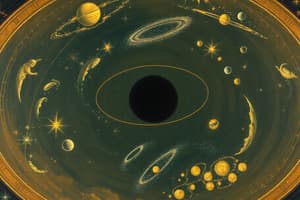Podcast
Questions and Answers
What is the concept of the universe described in Stoic philosophy?
What is the concept of the universe described in Stoic philosophy?
- An oscillating universe of infinite expansion.
- An island universe surrounded by an infinite void. (correct)
- A geocentric universe with celestial spheres.
- A static universe that changes over time.
Which term is used to describe the universe in Biblical cosmology?
Which term is used to describe the universe in Biblical cosmology?
- Geocentric universe
- Created by God (correct)
- Infinite void
- Cyclical universe
What are the two forces described that act on the elements according to the content?
What are the two forces described that act on the elements according to the content?
- Gravity and Light
- Gravity and Levity (correct)
- Attraction and Repulsion
- Expansion and Collapse
What is the significance of the term 'Bindu' in the Brahmanda theory?
What is the significance of the term 'Bindu' in the Brahmanda theory?
Which best describes the concept of the universe in the Aristotelian view?
Which best describes the concept of the universe in the Aristotelian view?
How is the concept of a rogue star defined?
How is the concept of a rogue star defined?
What does the term 'cosmology' refer to in the context of the universe?
What does the term 'cosmology' refer to in the context of the universe?
Which description corresponds to the term 'vortex' as used by Descartes?
Which description corresponds to the term 'vortex' as used by Descartes?
Flashcards are hidden until you start studying
Study Notes
The Nature of the Universe
- All reality and objects consist of atoms within an infinite void, forming various combinations and shapes.
- Cosmology is the study focusing on the origin, evolution, and eventual fate of the universe.
- The term "cosmos" is synonymous with the universe.
Theories of the Universe
- The Aristotelian Universe is geocentric, positioning the Earth as the stationary center surrounded by concentric celestial spheres containing planets and stars.
- This model suggests that the universe is unchanged and static throughout eternity.
Fundamental Concepts
- Oscillating refers to motion that swings back and forth at a regular speed.
- Stoic philosophy emphasizes endurance of pain without visible complaint.
- A vortex, in Descartes' view, refers to a large, swirling mass of material particles.
- Rogue stars are intergalactic stars that have escaped their galaxy's gravitational pull, moving freely in the void.
Biblical and Philosophical Interpretations
- In Biblical accounts, God is believed to be the creator of the universe.
- The concept of Brahmanda, from the Hindu Rigveda, describes a cosmic egg representing a cyclical universe that expands and collapses infinitely.
- The universe begins from a single point called a Bindu and follows a cycle of expansion and total collapse.
Elements and Forces
- The classical elements in ancient theories include fire, air, earth, and water, acting in response to two forces:
- Gravity: the tendency of earth and water to sink.
- Levity: the tendency of air and fire to rise.
- Aether is defined as the void that pervades the universe, above terrestrial boundaries.
Stoic Universe
- The Stoic perspective describes the universe as an island, finite in nature, but surrounded by an infinite void.
- It characterizes the universe as a giant living body, reflecting a holistic view of existence.
Studying That Suits You
Use AI to generate personalized quizzes and flashcards to suit your learning preferences.




